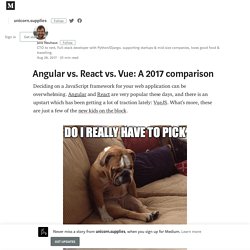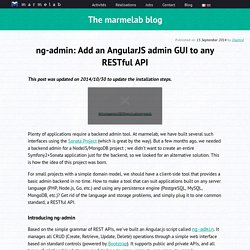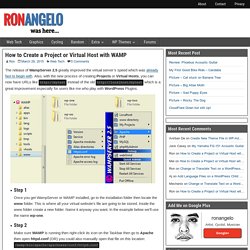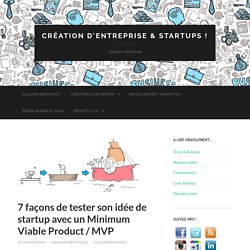

Iframe/ShadowRoot. SEO. SendInBlue. The W3C Markup Validation Service. Angular vs. React vs. Vue: A 2017 comparison – unicorn.supplies. Deciding on a JavaScript framework for your web application can be overwhelming.

Angular and React are very popular these days, and there is an upstart which has been getting a lot of traction lately: VueJS. What’s more, these are just a few of the new kids on the block. So, how are we supposed to decide? A pros-and-cons list never hurts. We’ll do this in the style of my previous article, “9 Steps: Choosing a tech stack for your web application”. Before we start — SPA or not? You should first make a clear decision as to whether you need a single-page-application (SPA) or if you’d rather take a multi-page approach. The starters today: Angular, React and Vue First, I’d like to discuss lifecycle & strategic considerations.
Here are the questions we’ll address today: How mature are the frameworks / libraries? Ready, set, GO! 1. 1.1 Some history Angular is a TypeScript-based Javascript framework. React is described as “a JavaScript library for building user interfaces”. 1.2 Core development.
REACT. AngularJs. The best web text editor for everyone. Sass. Angular Material. Angular2. Ng-admin: Add an AngularJS admin GUI to any RESTful API. This post was updated on 2014/10/30 to update the installation steps.

Plenty of applications require a backend admin tool. At marmelab, we have built several such interfaces using the Sonata Project (which is great by the way). But a few months ago, we needed a backend admin for a NodeJS/MongoDB project ; we didn’t want to create an entire Symfony2+Sonata application just for the backend, so we looked for an alternative solution. This is how the idea of this project was born. For small projects with a simple domain model, we should have a client-side tool that provides a basic admin backend in no time.
Introducing ng-admin Based on the simple grammar of REST APIs, we’ve built an Angular.js script called ng-admin. The initial video is a screencast of ng-admin running on top of a classic Post-Comments-Tags REST service. Ng-admin uses a simple configuration file, written in pure JavaScript, to describe the backend. Installation (FOS JsRouting Bundle documentation) How to Create a Project or Virtual Host with WAMP. The release of WampServer 2.5 greatly improved the virtual server’s speed which was already fast to begin with.

Also, with the new process of creating Projects or Virtual Hosts, you can now have URLs like instead of the old which is a great improvement especially for users like me who play with WordPress Plugins. Step 1Once you get WampServer or WAMP installed, go to the installation folder then locate the www folder. This is where all your virtual website’s file are going to be stored. Inside the www folder create a new folder. Name it anyway you want. To add another Project or Virtual Host repeat the steps above except for Step 2.
Gestion Publicité. Geoloc. HTML5. Bootstrap. Javascript. Java Web. PHP. DevOps. 7 façons de tester son idée de startup avec un Minimum Viable Product / MVP. A mes yeux, la plus grande cause d’échec des startups est très simple (si l’on parle chiffres uniquement) : c’est le fait DE NE PAS SE LANCER.

C’est fou le nombre de personnes qui ne donnent pas une chance à leurs idées, qui s’autocensurent… Et c’est en réalité bien dommage. Chaque fois qu’un entrepreneur en puissance (on parle de wantrepreneur) tue de lui-même une idée, c’est un peu de l’écosystème de startups qui y perd. Il y a à cela plein de raisons, mais je pense que la principale est le fait de croire que cela va être trop compliqué de faire les premiers pas.
Le gap a l’air trop important aux yeux du wantrepreneur entre sa situation actuelle (étudiant, salarié, retraité) et le statut d’entrepreneur. Pourtant, il existe une bonne façon, même en étant déjà en poste (lisez d’ailleurs aussi cet article), de tester son idée : il s’agit de commencer à se lancer dans la création. Poser une landing page et un formulaire d’inscription. Et vous, vous avez testé comment ?
Search engine. Facebook crawler.